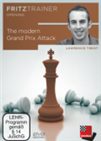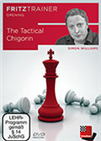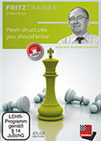A review

Thanks to the opening of a chess club in my city, now I have the chance to play more tournaments, and more blitz rated events.
Recently, at the chess club, I began a series of matches one-on-one: six games with long time control, and ten blitz games.
After the first match with this format, I realized I could have scored more points, if I had a blitz repertoire, and here this DVD by Trent comes in handy, because it can give me a repertoire to definitely surprise my opponent, with sharp lines that are definitely difficult to refute in a blitz over-the-board game.
I'd like to praise Trent's intellectual honesty, because not even one minute into the introductory video he says clearly: "The Albin cannot be played after the move 2.Nf3."
I'm mentioning this point, because many titled players when giving a repertoire or an opening system, they tend to avoid or minimize the problems. Trent instead took the bull immediately by the horns!
 The Grand Prix Attack is one of White’s most enterprising weapons against the Sicilian Defence, and a favourite among club players and Grandmasters alike. This is an opening that must be treated with both caution and respect. Over the past few years Grandmaster Gawain Jones, arguably the world’s leading expert on the variation, has used the Grand Prix Attack to defeat a number of world class opponents, which demonstrates that underestimating its potential can cause casualties even at the highest level. This DVD will provide you with a comprehensive repertoire that explores all of Black’s ideas against the Grand Prix set up.
The Grand Prix Attack is one of White’s most enterprising weapons against the Sicilian Defence, and a favourite among club players and Grandmasters alike. This is an opening that must be treated with both caution and respect. Over the past few years Grandmaster Gawain Jones, arguably the world’s leading expert on the variation, has used the Grand Prix Attack to defeat a number of world class opponents, which demonstrates that underestimating its potential can cause casualties even at the highest level. This DVD will provide you with a comprehensive repertoire that explores all of Black’s ideas against the Grand Prix set up.On the other hand, in times where most people don't care about a precise use of the language (apart from the grammar police!) I believe it was obvious, since it's called: "counter-gambit" which means White must gambit first, in order to have a counter-gambit, and 2.Nf3 is not a gambit!
I'd like to praise Trent also for another reason. In the database of model games, he not only put the games he won, but also one he lost, which shows he is a mature and responsible coach, unlike those concocting a magic aura of invincibility for the opening they are teaching.
To tell you the truth, there is another product by ChessBase, authored by Trent which is really worth having: The Modern Grand Prix Attack. I remember I bought it for learning how to fight the Sicilian, and it really worked, because even against players 200 points above me, I was able — thanks to the good lessons given by Trent — to stand my ground, and either win or draw. Returning to the newest DVD, Trent solves the question of 2.Nf3 saying: "however the 70% of players play 2.c4." Which is not really a good answer, because I need a repertoire for blitz. So I returned to another product I briefly studied, but didn't use — one which now could come handy too: "The tactical Chigorin" by Simon Williams.
In that video series, GM Williams, on video 24, covers the possibility that White tries to avoid 2.c4, with the following line: 1.d4 d5 2.Nf3 Nc6 3.Bf4/Bg5/g3 (from A. Adorjan vs A. Morozevich).
I give the game because I'm interested in writing articles which are useful to my fellow chess players, however in the Chigorin DVD the game is heavily annotated, and then, of course, Williams also dedicates an entire 20 minutes video to it, explaining the move order, and what Black should do, etc.
 Opening with the Chigorin shows your intention to play for a win right from the outset. After 2...Nc6 Black's pieces fly into the game putting pressure on White's position from a very early stage. This opening is ideal for the type of player who strives for an unconvential yet attacking game right from the start.
Opening with the Chigorin shows your intention to play for a win right from the outset. After 2...Nc6 Black's pieces fly into the game putting pressure on White's position from a very early stage. This opening is ideal for the type of player who strives for an unconvential yet attacking game right from the start.There is also another reason why one should know the Chigorin Defence. During the second video, Trent analyses some rare third move sidelines. The following one could be a transposition into the Chigorin: 1.d4 d5 2.c4 e5 3.cxd5 Qxd5 now if White plays 4.Nf3 and Black continues with 4...Nc6 5.Nc3 Bb4 6.Bd2 Bxc3 7.Bxc3 this transposes to a Chigorin, so once more it becomes useful to study the DVD made by Williams.
If Black doesn't want to transpose, then after 1.d4 d5 2.c4 e5 3.cxd5 Qxd5 4.Nf3 Black needs to play 4...exd4 and Trent covers that.
The point here is thanks to the ChessBase training system I can cover most of my needs, and create a repertoire for blitz. Obviously, I'm not covering all the possibilities, because this article is intended as a review of Trent's latest DVD, more than learning the Chigorin, but I do like to be prepared!
Trent informs us that the DVD has quite lengthy analysis, longer than in previous video series on openings he has made, because in this case, he is proving the soundness of the lines he proposes, with an accurate analysis bulletproofed by engines. This is especially important in today's engine world, where playing an unsound opening means losing points for no reason.

Between the modern names who play this opening we see former world champion Kasimdzhanov, then a name synonymous with creativity: Morozevich, and the Swedish champion: Tikkanen. Among the classical masters, we have obviously Albin, Geza Maroczy and Frank Marshall, just to mention few who played the opening consistently.
I'd like to share this masterpiece played by Trent, because it reminds me of Rotlewi vs Rubinstein, a famous game in which many pieces are sacrificed or left en prise.
Returning to the DVD, Trent emphasizes the need to repeat the lines and understand them. Today also in ChessBase there are tools which can help us to do that.
What I mean here is "praxis" an ancient Greek word which symbolizes the idea of practising. But practising what? Trent shows some lines, and tell us he would prefer that endgame compared to another when he says that one must stop the video, copy the FEN of that position, and then play it against an engine or a sparring partner. Here I'd like to give some of the positions I've seen, which in my opinion one must play before the tournament, to acquire that kind of understanding needed to play the opening correctly.
Black just played 12...h5 White to move, here one should play it as Black against an engine, and see if he is able to convert the pawn sacked, with a strong successful attack on the White king. If one can't, then he should try as White to resist the attack. In this way, one learns both sides and becomes acquainted with the plans, and tactics in the position.
Black just played 12...c6; this position is equal, and that's when things are difficult. One should spend 15-20 minutes to imagine which plans White will employ, and what to do as Black.
Here Trent shows this position which is equal, but he prefers Black's queenside majority. Again, one should not have to work it all out at the board, but rather practise beforehand.
I'd like to mention another position, in relation to the ChessBase training system. After the moves: 1.d4 d5 2.c4 e5 3.e3 exd4 4.exd4 Nf6 5.Nc3 Bb4
 Every pawn structure has its typical plans and to know these plans helps you to find your way in these positions. On this DVD Mikhalchishin presents and explains the most common central structures: The Hedgehog, the Maroczy, Hanging pawns and the Isolani.
Every pawn structure has its typical plans and to know these plans helps you to find your way in these positions. On this DVD Mikhalchishin presents and explains the most common central structures: The Hedgehog, the Maroczy, Hanging pawns and the Isolani.This is a position which could arise from the French Defence and could lead to an Isolated Queen Pawn. So why is the ChessBase training system such an asset? Because there is a DVD, made by Senior FIDE trainer GM Mikhalchishin, which teaches us all about these pawn structures, and how to deal with them.
The opening is not only memorizing some lines and moves, it is the core learning system which opens our minds to what to do, depending on which pawn structure we encounter. To study the opening distinct from the actual middlegame and endgame is foolish.
The positions above are just a small sample gathered from one video clip, but they are much more useful to prepare you for a tournament, than a typical tactic training, because they will happen in your games if you play the Albin Counter-Gambit, and to be familiar with them means to save a lot of time on the clock.
By now the reader of this article will want to know precisely the content of the DVD. The series is divided into four chapters, which cover all the lines of the Albin's counter-gambit for a total of 22 videos — slightly over 5 hours. The fifth chapter is dedicated to the interactive quizzes, where Trent presents a position, and one must find the right move. The quiz section is made up of 15 video clips, with feedback. This is useful training, and can last hours, or at least give us feedback on which parts we didn't fully understand.
Final thoughts
Play the Albin counter-gambit, because it will teach you chess! Buy the DVD, play each line against an engine or a sparring partner, and you'll become a new better player in the process. One can become a player who knows how to exploit a tempo in the opening to one's own advantage. A player who, like Morphy, understands development, the initiative, and the attack!
On this DVD IM Trent shows the Albin Counter-Gambit (1.d4 d5 2.c4 e5). Trent found a number of extremely dangerous Theoretical Novelties which will truly put the Albin Counter-Gambit back on the map.
Links
























